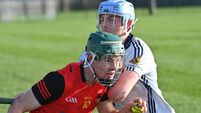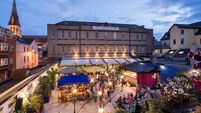George Berkeley, the famous philosopher and empiricist was Bishop of Cloyne from 1734 onwards.
There is a monument to him at the cathedral in Cloyne. The famous University of California, Berkeley and the city where the campus sits are named after him.
However, there’s little talk of George in Cloyne. Not even a pub named after him. Berkeley, like us all, takes his place in the shadow of Christy Ring.
No matter how Cloyne grows, expands and changes it will always be Christy Ring’s home place. Yes, he left us and he did play with the Glen. The Cloyne GAA crest represents this fittingly: two crossed hurleys, with two crosses either side to mark both churches in the town. The round tower in between. The words Cluain Uamha, ‘meadow of the caves’, that describe the place so aptly.
All below the star, the star that represents Christy — but with a teardrop taken from the star to represent his leaving for whatever reason and the hope that we would always be strong enough for this to never happen again.
In some respects, he is a ghost around Cloyne. Why did he leave? What did everybody learn from it?
In the end, though, he was a Cloyne man and he was borne back to Cloyne. So maybe you do what you need to do, come what may. But the ghost says once a Cloyne man, always one.
An experience for us all in Cloyne is the walk to school every day. Pass down Chapel St towards Spit Lane and two statues loom on either side of the road. A narrow road and a letter separating their names: One called Christ with a cross in his hands and the other called Christy with a hurley in his hand.
Christy, marching into battle with that powerful pose of his. Like many a child in Cloyne, I spent many hours praying to one to be as good as the other.
The stories of Ring and Cloyne are endless. The fondest are the simplest. Saturdays were his day for hurling in Cloyne. The sight of new sliotars being pucked over the hedge for the waiting Cloyne lads would announce his arrival.
Games for hours would follow. Backs and forwards, no mercy shown or asked.
Ring might have a Munster final the next day but would never give in. The Cloyne lads would never hold back worrying about the prize Ring would be playing for just 24 hours later.
The only reason to stop was failing light, or when Christy’s sister Mary Agnes would call a halt for a water-break. A dish full of water with a couple of ponnies floating inside. Legend had it that the last one to drink from the dish would be drinking more blood than water.
Ring is much more than fond stories, though. Ring was an elite sports person. A professional in an amateur setting.
Jack Lynch remarked at his graveside in Cloyne, “Had Christy applied his talents to another code, to another sport that had international participation, I believe he would have achieved the same degree of perfection in it as he did in hurling and would have won world renown.”
His eight All Ireland medals, nine Munsters, or 14 senior county titles are a testament to this. But his longevity at the top marks him apart and his record with Munster best illustrates this.
At a time when the Railway Cup was a coveted title, Ring’s record is remarkable. He played 22 years for Munster winning 18 times. More so, given the type of game he played, as the main scoring threat often at the edge of Hell’s Kitchen.
How close did he come over those years to receiving a career-ending blow? The Independent reported on the Monday morning after the controversial 1961 Munster Final that John Doyle and himself became ‘enmeshed in a catch-as-catch-can or punch-as-punch-can on the ground 18 minutes after the restart’.
How many savage defenders of that era cherished the thought of Ring’s scalp?
What a pity Ring didn’t live longer. I spent hundreds of hours with his two brothers Paddy Joe and Willie John. Both different characters. Both in love with the game. But what would Christy have been like had he lived to old age? What would he have thought of things?
Many enlist the ghost of Christy from the grave to support their present-day arguments but he mightn’t subscribe that easily to them today.
What would he have thought of the current game? The players of today? A man who changed the game had to have dreams and vision. A man who spoke about the virtues of an all-goals game of hurling had to have imagination.
Is part of Ring’s enduring importance down to timing? He had a massively long career but he drew the curtain down on it just as television coverage dawned. He left enough in the record books to inform his greatness and just enough in the old reels to show its quality — but most of his great deeds were seen by live audiences in the instant and never seen again, or they were relayed over the wireless across the island and in newsprint. They were fixed in the imagination at a time when images and memories were less disposable.
If Cú Chulainn was around now he’d pack it in after 10 minutes of Sunday Game analysis, with the Twitter scroll running bitterly across the bottom of the screen. There’s cheap notoriety to be had nowadays by playing the contrarian pundit.

Ring played for a long time and in an era when hurlers were more distinctive because of the lack of headgear. In his youth, he had the film star looks. As time went on, he was broadly built, bald and distinctive, a mesmerising fixture in big events.
The sense of excitement when you listen to stories of people seeing Ring play. Of how everyone would ask the same question in the following days: What was Ring like?
Imagine the scene in Cloyne’s St Colman’s Terrace on a summer’s day. A crowd gathered around the wireless powered by homemade batteries, the signal ebbing and flowing. The mystique of what was happening in Thurles, Limerick or Croke Park being transmitted from the commentary box in the stadium. What did he say there? What’s the score? How is Christy doing? Be quiet, we can’t hear it with you.
Nowadays a lad could score four goals in an All-Ireland final and social media might tear him apart by game’s end. Ring lived in a lovely time for sport. Maybe amongst his greatest feats was getting his timing bang on.
Ring is many things. As my grandmother Frances would say, a Ring herself, there is no end to a Ring. He is a symbol. When a parent tells their kids in Cloyne that they can be anything they want to be, remember that a man from down the street became the greatest player in the greatest game.
He has left a light on for those who believe in excellence, commitment, and obsession.
This light shines in Cloyne through Ring and will shine forever as a beacon for those who believe that hurling deserves it.
- You can purchase the Irish Examiner's 20-page special publication to mark the centenary of Christy Ring's birth with your Friday edition of the Irish Examiner in stores or from our epaper site.

Unlimited access. Half the price.
Try unlimited access from only €1.50 a week
Already a subscriber? Sign in
CONNECT WITH US TODAY
Be the first to know the latest news and updates













